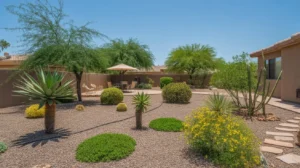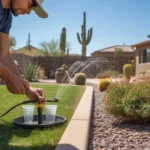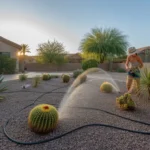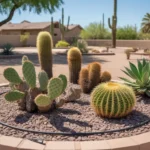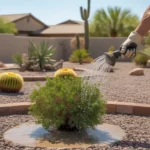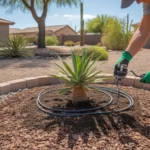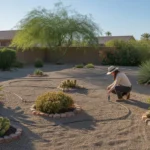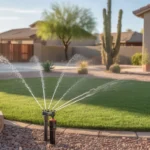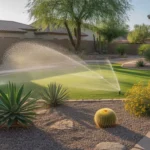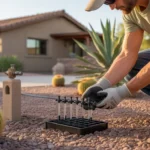Keeping your Queen Creek yard lush and healthy under watering restrictions can feel like a challenge, especially during our hot, dry summers. But with some smart strategies and efficient irrigation practices, you can maintain a beautiful landscape while following local guidelines. Here’s what you need to know about Queen Creek’s watering restrictions and how to adapt your yard to thrive in dry conditions.
Understanding Queen Creek’s Watering Restrictions
Queen Creek, like many cities in the Valley, has implemented watering restrictions to promote water conservation and responsible irrigation practices. From May 1 through October 31, outdoor watering is prohibited between 9 AM and 5 PM. This helps minimize water loss from evaporation during the hottest parts of the day.
Additionally, even-numbered addresses may water on even-numbered calendar days, while odd-numbered addresses water on odd-numbered days. This alternating schedule helps distribute demand on the water system. It’s important to follow these restrictions to avoid fines and do your part to conserve our precious water resources in the desert.
Keep in mind that these restrictions apply to sprinklers and irrigation systems. Hand watering with a hose or can is allowed any time, but it’s still best to avoid the heat of the day for maximum efficiency. Drip irrigation is also exempt from the time-of-day restrictions due to its water-saving nature.
Watering Deeply and Infrequently
One of the keys to maintaining a healthy yard under watering restrictions is to water deeply and infrequently. This means giving your plants a good, thorough soak less often, rather than frequent shallow watering. Deep watering encourages roots to grow deeper into the soil, making plants more drought-resistant.
For lawns, aim to water to a depth of 6-8 inches. This typically means running sprinklers for longer cycles, but less frequently. For example, instead of 10 minutes every day, try 30 minutes 3 times per week. Adjust based on your soil type and yard’s unique needs.
For trees, shrubs, and perennials, deep watering is even more crucial. These plants have extensive root systems that need moisture further down in the soil profile. Slow, deep irrigation with drip emitters or a soaker hose can effectively deliver water without waste. A good rule of thumb is to water established trees and shrubs deeply once per week during summer.
Maximizing Irrigation Efficiency
Making the most of every drop is essential under watering restrictions. This means fine-tuning your irrigation system for maximum efficiency. Start by auditing your system for any leaks, broken heads, or misdirected sprays. Even small issues can waste significant amounts of water over time.
Consider upgrading to high-efficiency nozzles that deliver water in larger droplets to minimize drift and evaporation. Smart controllers that adjust watering based on weather conditions can also help optimize your scheduling. And don’t forget the power of drip – converting spray zones to drip irrigation can dramatically reduce water use while delivering moisture right to the root zone.
Proper maintenance is also key. Regularly check and clean your irrigation filters, especially if you have hard water in Queen Creek. Clogged emitters can cause uneven watering and stressed plants. Flush your drip lines periodically to remove any built-up debris and keep water flowing freely.
Choosing Drought-Tolerant Plants
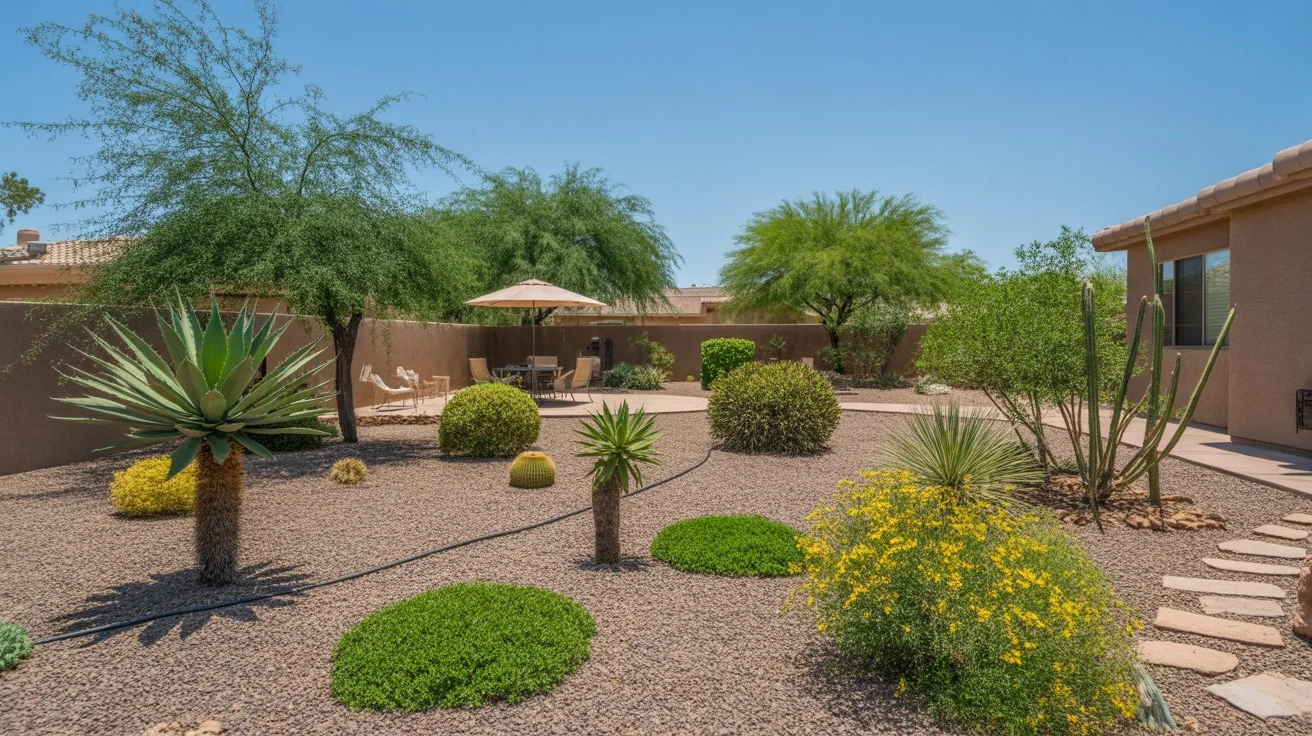
One of the best ways to create a low-water yard is to choose plants that are naturally adapted to arid conditions. Queen Creek’s desert climate is perfect for a wide variety of beautiful, drought-tolerant options.
For trees, consider native mesquites, palo verdes, or desert willows. These hardy specimens can thrive on minimal water once established. Shrubs like Texas sage, brittlebush, and creosote offer attractive foliage and flowers with little irrigation needed.
When it comes to groundcovers and perennials, there are plenty of low-water choices beyond the ubiquitous gravel. Plants like blackfoot daisy, damianita, and desert marigold create carpets of color that can handle the heat. Succulents like agave, yucca, and hesperaloe also make striking accents with very low water needs.
Mulching and Shading for Water Retention
In addition to plant selection, your yard’s environment can help or hinder water retention. Bare soil quickly loses moisture to evaporation, so mulching is a must. A 3-4 inch layer of organic mulch or decorative rock helps shade the soil, reduce evaporation, moderate soil temperatures, and retain moisture for plant roots.
In Queen Creek, inorganic mulches like decomposed granite or river rock are popular choices that stand up to the elements. They allow water to percolate through while providing an attractive, desert-friendly look. Organic mulches like shredded bark or wood chips are also beneficial, especially for trees and shrubs.
Providing shade is another way to reduce water needs in your yard. Shade lowers air and soil temperatures, minimizing stress on plants. Consider creating micro-climates in your yard using trees, shrubs, or shade structures. Sensitive plants like vegetables or flowers will require less water when grown in dappled light versus direct sun.
Timing and Technique Matter
When you water is just as important as how much under restrictions. Always aim to irrigate in the early morning hours when evaporation is lowest and plants can efficiently uptake moisture. Watering too late in the evening can promote fungal growth and disease.
Technique also matters for making the most of limited watering windows. For lawns, use a cycle-and-soak method by breaking up your watering time into shorter cycles spaced an hour apart. This allows water to penetrate slowly without runoff. For trees and shrubs, use a hose on a slow trickle or install a bubbler at the root zone to deeply saturate the soil.
Hand watering is also a useful technique for spot-checking dry areas or caring for container plants. A watering wand with a shutoff valve lets you efficiently target water without waste. And don’t forget to regularly check your soil moisture to gauge when plants truly need irrigation.
Adapting to Seasonal Shifts
Queen Creek’s watering restrictions change with the seasons, so it’s important to adapt your practices accordingly. In the winter months from November through April, irrigation is prohibited between 9 AM and 5 PM, and the even/odd address schedule remains in effect.
However, cooler temperatures and dormancy mean plants typically require much less water during this time. You may only need to irrigate every 2-4 weeks, depending on rainfall and plant type. Adjust your controller’s seasonal settings to avoid overwatering and wasted resources.
As temperatures warm up in spring, gradually increase watering frequency to support active growth and new plantings. Remember that even desert-adapted plants need regular moisture to get established. Applying a water-efficient transplant solution can help reduce shock and improve root development.
The Bottom Line on Watering Restrictions
While Queen Creek’s watering restrictions may seem like a burden, they’re an important part of responsible desert living. By choosing efficient irrigation practices, drought-tolerant plants, and water-wise techniques, you can keep your yard thriving without breaking the rules. Embrace the challenge as an opportunity to create a beautiful, sustainable landscape that’s perfectly in tune with our arid environment.

